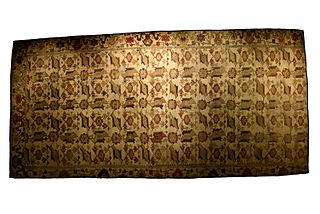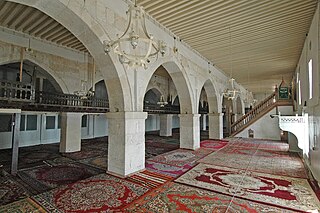
Konya Province is a province and metropolitan municipality in southwest Central Anatolia, Turkey. Its area is 40,838 km2, making it the largest province by area, and its population is 2,296,347 (2022). The provincial capital is the city of Konya. Its traffic code is 42.

İnce Minareli Medrese is a 13th-century madrasa located in Konya, Turkey, now housing the Museum of Stone and Wood Art, noted for its ornate entrance, domed courtyard, ornamentally bricked minaret, partially destroyed in 1901, and exemplar Anatolian Seljuk architecture.

Following the proclamation of the Republic, Turkish museums developed considerably, mainly due to the importance Atatürk had attached to the research and exhibition of artifacts of Anatolia. When the Republic of Turkey was proclaimed, there were only the İstanbul Archaeology Museum called the "Asar-ı Atika Müzesi", the Istanbul Military Museum housed in the St. Irene Church, the Islamic Museum in the Suleymaniye Complex in Istanbul and the smaller museums of the Ottoman Empire Museum in a few large cities of Anatolia.

Divriği Great Mosque and Hospital is a mosque and hospital complex built in 1228–1229 by the local dynasty of the Mengujekids in the small Anatolian town of Divriği, now in Sivas Province, Turkey. The complex is located in the upper town, below the citadel. The exquisite stone carvings and eclectic architecture of the complex places it among the most important works of architecture in Anatolia and led to its inclusion on UNESCO's World Heritage List in 1985.

The Alâeddin Mosque is the principal monument on Alaaddin Hill in the centre of Konya, Turkey. Part of the hilltop citadel complex that contained the Seljuk Palace, it served as the main prayer hall for the Seljuk Sultans of Rum and its courtyard contains the burial places of several of the sultans. It was constructed in stages between the mid-12th and mid-13th centuries. It is the largest of several Seljuk mosques to survive in Konya.

Karatay Madrasa is a madrasa in Konya, Turkey located at the foot of the citadel hill, across from the ruins of the Seljuk palace and in view of the Alâeddin Mosque. Since 1954, the building has served as a museum displaying a collection of historic tile art, particularly from the Seljuk period. The madrasa and the Karatay Han, a caravanserai completed in the 1240s, are the largest extant monuments in Konya and its immediate regions.

Eşrefoğlu Mosque is a 13th-century mosque in Beyşehir, Konya Province, Turkey It is situated 100 metres (330 ft) north of the Beyşehir Lake

Aziziye Mosque or is an Ottoman mosque in Konya, Turkey. It is well known for the columned balcony of its minaret, an architectural feature rarely seen in Turkish mosques.

Tarsus Museum is an archaeology and ethnography museum in Tarsus, Mersin Province, in southern Turkey.

Konya Archaeological Museum is a state archaeological museum in Konya, Turkey. Established in 1901, it had been relocated twice before moving to its present location in 1962. One of the most prominent displays in the museum is of sarcophagi and other antiquities from the ancient city of Çatalhöyük. Other exhibits relate to the Neolithic, Bronze Age, Iron Age, Classical, Hellenistic, Roman and the Byzantine periods; artifacts consist of ceramic ware, stone and bronze wares, ornaments and inscriptions. Among the objects displayed is a marble sarcophagus of the 3rd century AD, with elaborate relief sculptures depicting the life of Hercules. In the outer open yard of the museum there are a number of small sculptures, sarcophagi, column capitals, and samples of epigraphy.

Konya Ereğli Museum is an archaeological and ethnographic museum in Ereğli district of Konya Province, Turkey. Situated in the İstasyon cad, it is operated by the Ministry of Culture and Tourism.
Amasya Museum, also known as Archaeological Museum of Amasya, is a national museum in Amasya, northern Turkey, exhibiting archaeological artifacts found in and around the city as well as ethnographic items related to the region's history of cultural life. Established in 1958, the museum owns nearly twenty-four thousand items for exhibition belonging to eleven historic civilizations.

Akşehir Museum, a.k.a. Nasrettin Hoca Archaeology and Ethnography Museum, is a national museum in Akşehir district of Konya Province, central Turkey, exhibiting archaeological artifacts and ethnographic items. Established in 2007, it is dedicated to Nasrettin Hoca, a satirical figure in Turkish history and folklore, whose tomb is in Akşehir.

Bolu Museum is a museum in Bolu, Turkey. Bolu was a leading city of the Bithynia kingdom in antiquity.
Karadeniz Ereğli Museum is a museum in Ereğli ilçe (district) of Zonguldak Province, Turkey. The modifier Karadeniz is used to distinguish Ereğli in Zonguldak Province from another similar-named ilçes in Konya and Tekirdağ Provinces.

Konya Ethnography Museum is an ethnographic museum devoted to the people, cultures and lifestyle in and around Konya, Turkey.

Kileci Mosque is a small historical mosque in Akşehir, Turkey. It is a 13th-century mosque built during the Sultanate of Rum era. But the exact construction date, the commissioner and the architect are not known.

Taşmedrese is a 13th-century religious complex in Akşehir, Turkey.

Ermenek Grand Mosque is located on the outskirts of Ermenek Castle on an outcrop that overlooks the city of Ermenek. The mosque was built by Mahmud Bey of the Karamanids in 1302AD (702AH), as inscribed in Sülüs-style calligraphy on the original door wings between the antechamber and the prayer hall.

The Sahib Ata Complex is a historic funerary and religious complex located in Konya, Turkey. It was built between 1258 and 1285 by Sâhib Ata, the Persian vizier of the Sultanate of Rum. This religious complex consists of a mosque, mausoleum, khanqah and a hammam.



















